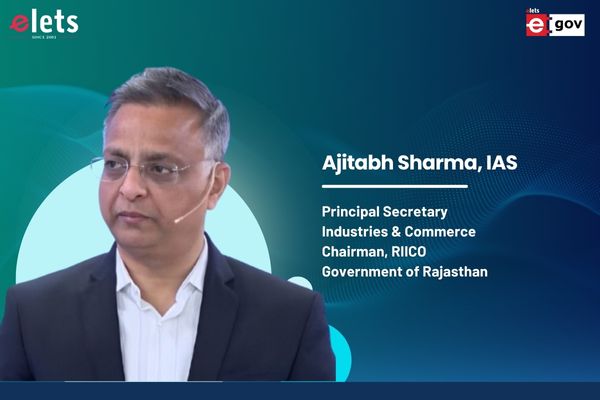
“The vision of e-Procurement project is to enhance the efficiency and transparency in public procurement through the implementation of a comprehensive, end – to – end e-Procurement solution and to route the entire public procurement activity being undertaken by the government through such a system in a phased manner,” says Aman Singh, Secretary Incharge (IT) and CEO Chips, Government of Chhattisgarh

What is the vision and objectives of the e-Procurement project of Chhattisgarh?
The vision of e-Procurement project is to enhance the efficiency and transparency in public procurement through the implementation of a comprehensive,end – to – end , e-Procurement solution and to route the entire public procurement activity being undertaken by the government through such a system in a phased manner. Effi ciency in handling public procurement by the government shall be enhanced through automation and process re-engineering wherein the e-Procurement system shall enable the government maintain a clear/unambiguous picture of its procurement activities on a realtime basis. Through e-Procurement in public procurement, our prime objective shall be to introduce utmost transparency, cost savings through higher competition, reduced inventory cost and the supplier community shall have an equal, fair and unbiased access to opportunities advertised online.
What are the departments that are being covered in the e-Procurement project? What is the estimated budget of the project?

The implementation of e-Procurement is phased according to function geography, value and time-. The term ‘function’ denotes the e-Procurement components implemented and the term ‘geography’ denotes the departments and locations at which the solution is being implemented. ‘value’ denotes the worthiness of transactions routed through the e-Procurement system.

The implementation of e-Procurement in Chhattisgarh is being done in two phases: pilot and rollout. In the pilot phase the Application Service Provider (ASP) has been asked to implement all the required modules on a test basis in the pilot departments identifi ed by the Government for the e-Procurement project. Public Works Department (PWD), Water Resources Department (WRD), Public Health Engineering Department (PHED), Health Department and Chhatisgarh State Industrial Development Corporation (CSIDC) has been identifi ed as pilot departments by the Government. Following the common practice of high value tenders fi rst, Government of Chhattisgarh (GoC) has mandated PWD, WRD, PHED and Health Department to adopt e-Procurement system for all their tenders worth INR 200 million and above and CSIDC to conclude all their Rate Contract tenders through the e-Procurement system. Subsequent to their successful adoption, the e- Procurement system shall be rolled out across the State to all Government departments, organisations, agencies, boards, etc. and also the tender slab of INR 200 million and above shall be lowered even further.

The Government of Chhattisgarh’s (GoC) annual public economic procurement expenditure is about INR 40,000 million and owing to the rapid development; this fi gure is expected to increase in the years to come. To increase the transparency and effi ciency, and also acknowledging the importance of the public procurement activity, the Government of Chhattisgarh decided to implement an end-to-end e-Procurement solution for all Government departments/ agencies/ boards across the State in a phased manner. The project is being done on a PPP model and there is no upfront fi nancial burden on the state government. The Application Service Provider (ASP) will be remunerated for the services rendered on a ‘transaction fee’ model. The transaction fees paid to the ASP is calculated at the module level. Some of the nine modules have been clubbed together and termed as a unit for the purpose of transaction fee calculation. The methods used for calculation of transaction fees are ‘Percentage of Estimated Contract Value (ECV) of a tender’, ‘percentage of order value’ and ‘fi xed fee per bid received’.
What architecture is being used to deploy the e-Procurement system in your state?
The e-Procurement solution implemented in Chhattisgarh is based on an n-tiered architecture with Web, application and database server farms. Each tier shall be scaled independently, both vertically and horizontally, to address the performance and scalability requirements as and when needed.
How is the security of information being maintained through the use of digital signature?
Harnessing the power of Security and ICT tools, the strong security measures have been incorporated in the e-Procurement system to maintain the confi dentiality and security of information.
From the bid preparation to the bid opening stage, we are using a secure bid process which has been patented by our Application Service Provider (Wipro Ltd.) wherein two very important stages of bidding have been introduced viz. a hash submission stage by bidders and a super hashing stage by the department. In case of bid tampering, that particular bid’s hash and the super hash will not match at the time of opening and tampering would be evident.
But it is worthwhile to mention that all encryption and decryption is handled on the client machine. So the data remains encrypted while in transmission from client – server – client and remains stored in encrypted form on the server. Every user has to mandatorily login using their user-id and password for accessing the tendering activity on e- Procurement website. For control and monitoring purpose, the login-id for respective department users is created by an administrative user nominated from their own department and the supplier community is provided with the login-id only after their successful registration/empanelment as per the requirements of the respective department(s).
The department of public works, water resources, health, public health engineering, Chhattisgarh state industrial development ltd., are already implementing e-Procurement in their procurement process. What has been the experience so far in terms of the benefi ts achieved in bringing about transparency and effi ciency in the procurement process?
According to the department heads who adopted the e-Procurement system for their tenders, one of the major benefi ts which is noticed is the elimination/ minimisation of cartel formation by bidders since the bidders are not aware of the bidding agency submitting the bid. This shall also have a direct impact on the cost of materials being procured by the government but it would be too early to point out any fi gures at this moment. However, national and international experiences are very encouraging and a saving of 5-10% is very normal. I remember a tender in one of our Works Department worth INR 1058 million (as per government estimates) through manual mode. On complaints, the Hon’ble Chief Minister directed us to do the same tender via e-Tendering. To our pleasant surprise, the lowest bid received was less by INR 223 million at INR 835 million due to intense competition. So the gains in savings are not only going to be huge but also recurring. The procurement cycle time also shall reduce once the users are well versed with the system.
What are some of the capacity building plans in this regard?
Owing to the new way of working for department users and supplier community, which the e-Procurement system brings and the huge user base to be trained, the strategy adopted for provision of the training is highly critical. As a fi rst step towards capacity building activity, we had organised many one day awareness programmes for both government offi cials and supplier community separately at various districts of the state.
In the fi nal step, to accustom the e-Procurement users, a comprehensive training calendar has been developed. Training would be conducted in Raipur in the initial phase and shall subsequently be conducted across the state in various districts. The training shall be provided in classroom context wherein the user community shall obtain hands-on experience in using the e-Procurement system. The size of the classroom is being kept small with about 25-30 users in a batch for increasing the effectiveness of the training. Simultaneously, in addition to training users in a class-room environment, other ways are being adopted such as a training facility at the ASP’s offi ce premises accessible to Government users and supplier community on a reservation basis, e-Learning method wherein, a screenshot wise, e-Procurement training manual have been uploaded on the website for ready reference and ‘Train the- Trainer’ method.
The e-Procurement project in Chhattisgarh is being implemented on the PPP model. What has been your experience with the private sector partners? What are some of the expectations from them?
Experiences show that IT is one area which is eminently suited for PPP. IT projects being undertaken by Governments have an opportunity cost associated to it. We, in fact every government, primarily adopted the PPP model to bridge the gap between levels of speed, effi ciency, reach of public projects and technical expertise. e-Procurement project is the fi rst PPP model project implemented in the State. We are also implementing our ambitious Chhattisgarh State Wide Area Network project and Common Services Centres Project on PPP model.
What are your plans for the e-Procurement project in the coming years?
As roll out depends on successful adoption of the e-Procurement system by the pilot departments, we plan to roll out successful pilot projects across all the government departments, agencies, boards, etc. in near future. Also, we shall further lower the tendering slab in consultation with the departments.
Be a part of Elets Collaborative Initiatives. Join Us for Upcoming Events and explore business opportunities. Like us on Facebook , connect with us on LinkedIn and follow us on Twitter, Instagram.
"Exciting news! Elets technomedia is now on WhatsApp Channels Subscribe today by clicking the link and stay updated with the latest insights!" Click here!













